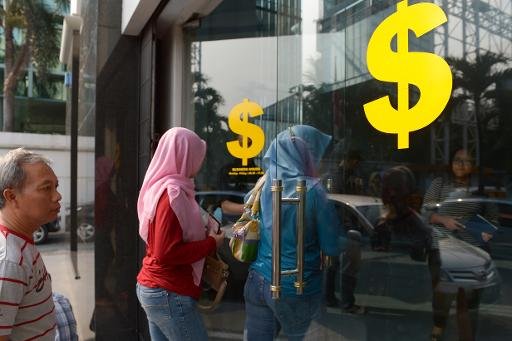 |
|
Indonesian customers enter a money changer office in Jakarta on September 4, 2013
|
Regional GDP growth in 2014 and 2015 was forecast at 7.2 percent for both years with middle-income economies like Indonesia, Malaysia and Thailand also softening. Excluding China, the region is expected to grow 5.2 percent in 2013 and 5.3 percent in 2014.
Bert Hofman, the World Bank's East Asia and Pacific chief economist, told journalists that the bank was expecting a "smooth resolution" of the budgetary impasse that has forced parts of the US government to shut down.
However, he added: "If there were to be a sustained deadlock, it could actually be quite damaging also for the East Asian economies.
"For every percentage point growth lost in the United States, we would see about half a percentage point growth lost in East Asia."
The US impasse has raised fears US lawmakers will not increase the country's borrowing limit before an October 17 deadline, which could lead the government to default on its debts.
Hofman said: "Any refusal on the increase in the debt ceiling is so unprecedented that it is very hard to predict what would happen. So we don't have that in the simulation."
In a report, the bank said East Asia is still the fastest growing in the world despite a slowdown in powerhouse China and a softening in places such as Indonesia and Thailand this year.
"East Asia-Pacific continues to be the engine driving the global economy, contributing 40 percent of the world's GDP growth -- more than any other region," said Axel van Trotsenburg, the World Bank's East Asia and Pacific Regional Vice President.
"With overall global growth accelerating, now is the time for developing economies to make structural and policy reforms to sustain growth, reduce poverty and improve the lives of the poor and vulnerable," he added in a statement.
The bank noted that in recent months speculation about the withdrawal of the US Federal Reserve's stimulus programme led to stock market sell-offs and currency depreciation in East Asia, hurting countries with large foreign participation in their financial markets.
The Federal Reserve's decision to delay (a wind down of the stimulus) stabilised markets for now, giving countries a second opportunity to take measures to lower risks from future volatility," said Bert Hofman, World Bank East Asia and Pacific Chief Economist.
"Reducing reliance on short-term and foreign currency denominated debt, accepting a weaker exchange rate when growth is below potential, and building policy buffers to respond to changing global liquidity conditions are some of the ways that can help countries be prepared."
The impact of any US tapering on capital inflows in the region may also be offset by "Abenomics", Japan's new strategy to revive growth, which could increase Japanese investment in the region, the bank said.
Structural reforms that will give people the opportunity to share in the gains of progress hold the key to future growth," said Hofman.

Leave your comment on this story